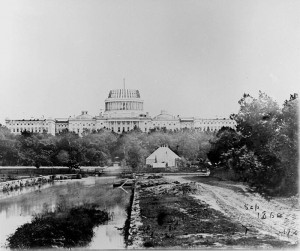The National Mall has a history of its own that is nearly invisible when walking its paths, and there is very little interpretation available on the Mall. Most visitors see what appears to be a finished product: a deliberately planned landscape with memorials, monuments, and museums symbolizing the history and values of the United States. The Mall, however, is a contested public space and its meanings, uses, and purposes have changed over time. In its earliest days, the Mall was a messy place where transportation arteries and commercial markets existed, and was bordered by lively neighborhoods.

Visitors, and many DC area residents, have no knowledge of the unregulated zone of muddy grounds, vegetable gardens, grazing cattle, or the slave pens that existed before the completion of the Washington and Lincoln Memorials. Thus, the Public Projects division of the Roy Rosenzweig Center for History and New Media, led by Sharon Leon and Sheila Brennan, thought there was an opportunity to build a mobile public history project around and about the complex, contested, yet often invisible history of the National Mall.
Our key strategy for making the history of the National Mall engaging for tourists was to create a website designed for hand-held devices, populated with surprising and compelling stories and primary sources that together build a textured historical context for the space and how it has changed over time. The project began in 2010 with research for a grant proposal to the National Endowment for the Humanities Public Programs Division for an implementation grant that was not funded. We revised and resubmitted in the same program the following year, and learned that we had received funding in April 2012. After two years of researching, planning, and waiting, we were ready to begin the process in earnest.
One of the biggest advantages for RRCHNM designing this project is that the Center is not a cultural institution sitting on the Mall. We relied on our experience as historians to shape the content and research and were not artificially constrained by institutional needs to favor the collections from one library, archive, or museum. We drew freely from resources housed at many cultural institutions, in and outside of Washington, DC.
As a stand-alone project, Histories did not need to replicate or reflect content in a physical exhibition. We let the sources and our questions as historians drive the interpretation, as we balanced the coverage of topics and themes across five centuries. We added a layer of rigorous historical interpretation to those sources, synthesizing the most recent public history scholarship, raising provocative questions about the space, its role in national life, and the expressions of American ideals that have taken place there. We also researched with the intention of uncovering sources that made visible the histories of indigenous people, segregation, slavery, unbuilt monuments, demolished structures, children, activists, and laborers. With this flexibility, we were also able to connect visitors on the Mall to the city of Washington, as a residential city with its role as the nation’s capital, in ways that are more difficult to see when visiting one of the monuments or museums.